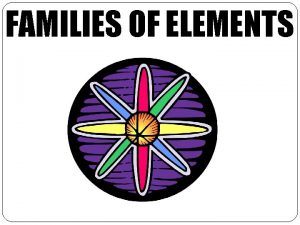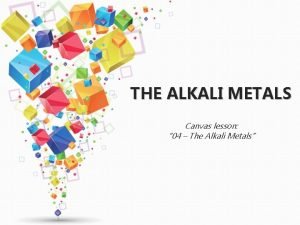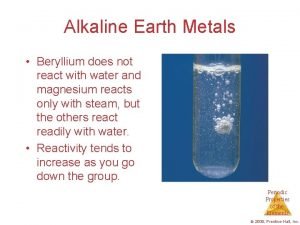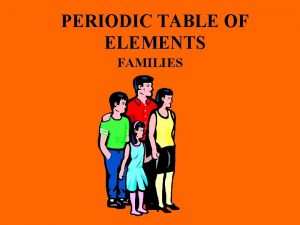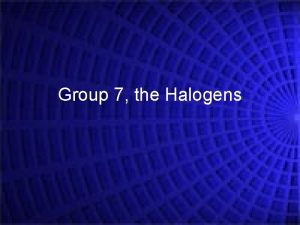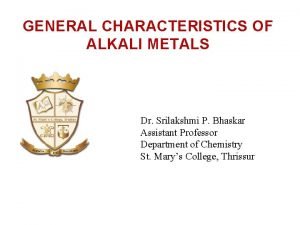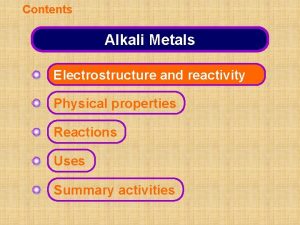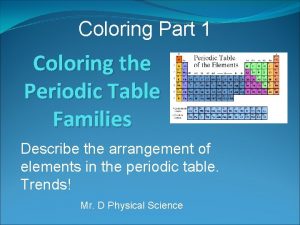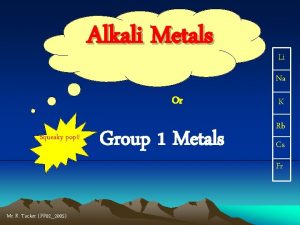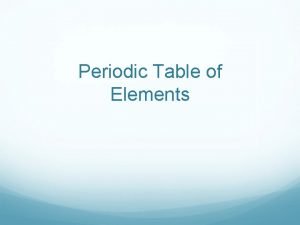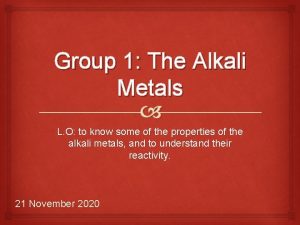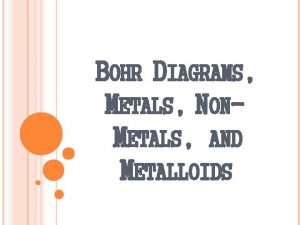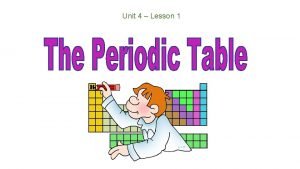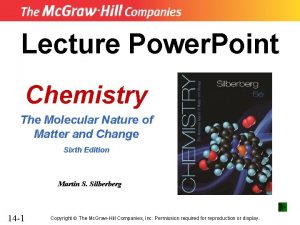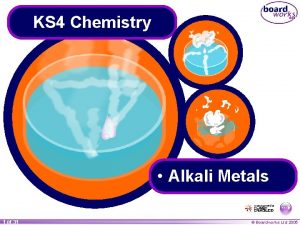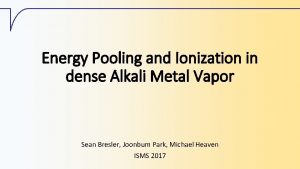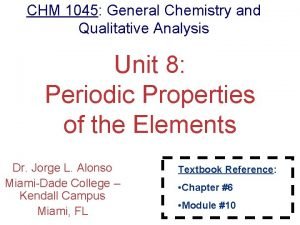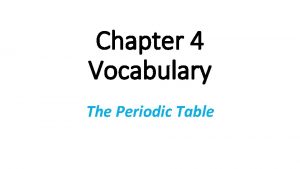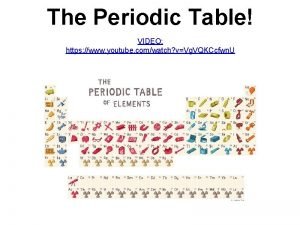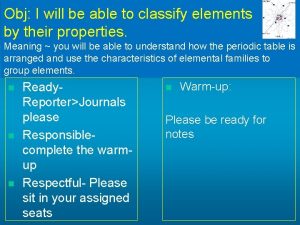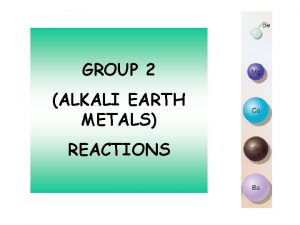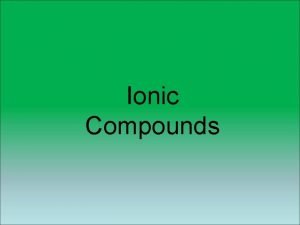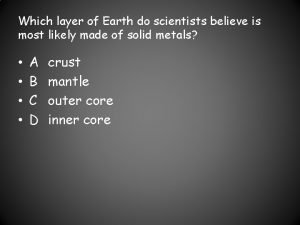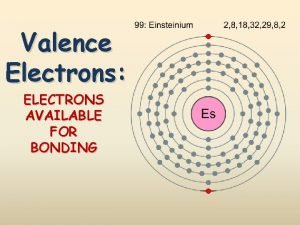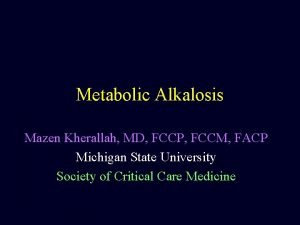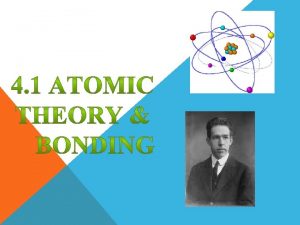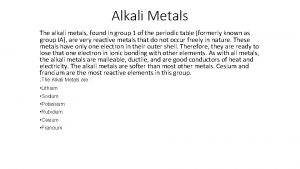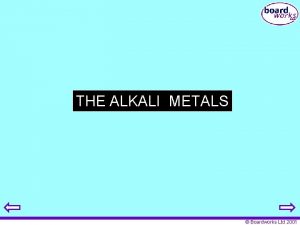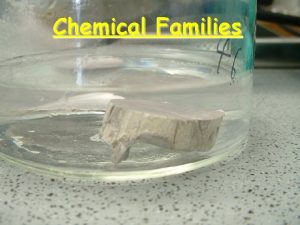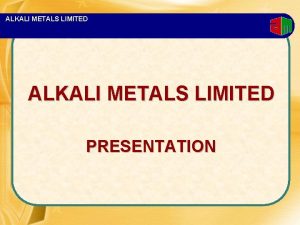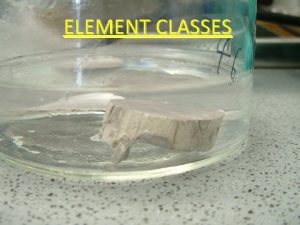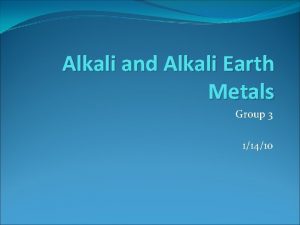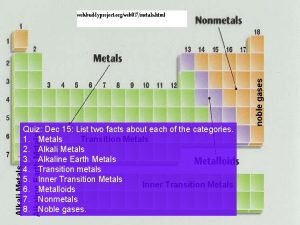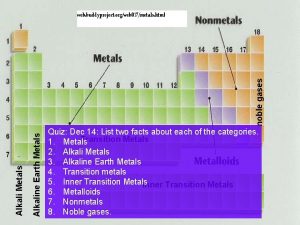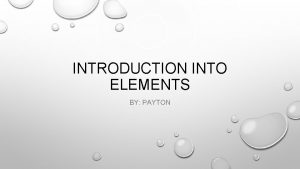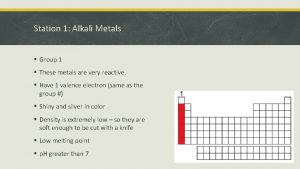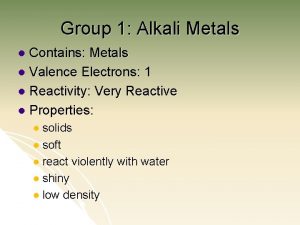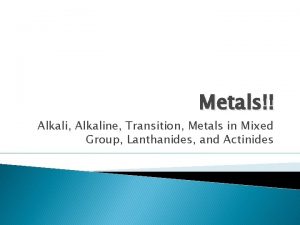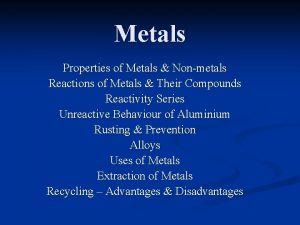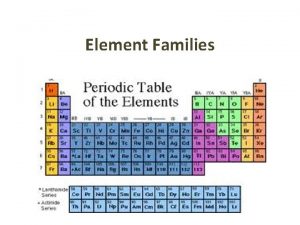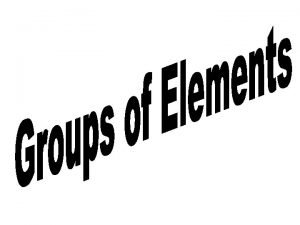GROUP 2 ALKALI EARTH METALS REACTIONS Group 2


























![Reactions with Acids The Simple Oxides [Li 2 O, Na 2 O] act as Reactions with Acids The Simple Oxides [Li 2 O, Na 2 O] act as](https://slidetodoc.com/presentation_image_h/7fd1a7fa2a8615d19db2865fec499dfa/image-27.jpg)













- Slides: 40

GROUP 2 (ALKALI EARTH METALS) REACTIONS

Group 2 metals (use pages 178 -179 ) How would you represent the first, second and third ionisation energies of a general metal? What does the first ionisation energy depend on? For a group two metal why is it impossible to lose 3 electrons to form a +3 ion? Does ionisation energy increase or decrease down the group? Explain your answer.

Questions from pages 179

Book answers


PROPERTIES Are ‘s’ block metals M. p. decreases down the group Have a valency +2 more reactive down the group They have more ionic character down the group Explain these properties

PROPERTIES Are ‘s’ block metals (2 electrons in the ‘s’ sub-shell) M. p. decreases down the group because the ionic radius increases down the group Have a valency +2 Electronegativities decrease down the group – so more reactive down the group. Ionic radius increases down the group

Reactions with OXYGEN ***Reactivity increases as you go down the Group These metals (X) burn in oxygen to form a simple metal oxide. 2 X(s) + O 2(g) 2 XO(s) Give three examples

Reactions with CHLORINE **Reactivity increases as you go down the group For each element’s reaction, there is a white solid residue which forms (simple chloride). X + Cl 2 XCl 2 If any of the elements are burned in chlorine, they would produce the same colours as they would if they were burned in oxygen (flame tests) *These metals are very reactive and have to be stored out of contact with air to prevent their oxidation.

Reactions with WATER ***Reactivity increases as you go down the group Be has no reaction with water / steam Mg has an extremely slow reaction in cold water to form a hydroxide and hydrogen. . . Mg(s) + 2 H 2 O(l) Mg(OH)2(aq) + H 2(g) When heated in steam, it burns quicker to form an oxide and hydrogen. . . Mg(s) + H 2 O(l) Mg. O(s) + H 2(g) Ca, Sr, Ba react with cold water with increasing vigour… X(s) + 2 H 2 O(l) X(OH)2(aq) + H 2(g)

Simple acid-base titration Risk assessment


SOLUBILITY OF GROUP 2 HYDROXIDES This increases down the group: Be(OH )2– insoluble Mg(OH)2 – very slightly soluble Ca(OH)2 – slightly soluble Sr(OH)2 & Ba(OH)2 – more soluble SOLUBILITY OF GROUP 2 SULFATES This decreases down the group: Be. SO 4 & Mg. SO 4 – very soluble Ca. SO 4 – slightly soluble Sr. SO 4 - very slightly soluble Ba. SO 4 – insoluble

SOLUBILITY OF GROUP 2 CHLORIDES All Group 2 chlorides are soluble in water SUMMARY OF GROUP 1 & 2 ELEMENTS These decrease down the group: Ø Melting temperature Ø Ionisation energy Ø Polarising power of the metal These increase down the group: Ø Atomic and ionic radii Ø Reactivity of the metal Ø Thermal stability of its compounds

THERMAL STABILITY Thermal stability describes how easily a compound can be broken down by heat. It depends on the polarising power of the metal. The larger the charge and smaller the radius, the bigger the charge density. Larger charge density means more polarising 1+ 2+ Li Be Na Mg K Ca Thermal stability increases down the group (harder to decompose the metal ) The ionic radius gets bigger down the group As the size of the ion increases, the polarising power decreases, so the compound is more stable

THERMAL STABILITY OF GROUP 1 NITRATES All Group 1 nitrates decompose on strong heating. However Li. NO 3 decomposes differently to the others… 4 Li. NO 3(s) 2 Li 2 O + NO 2(g) + O 2 The other nitrates decompose like so… 2 Na. NO 3(s) 2 Na. NO 2 + O 2 (g) THERMAL STABILITY OF GROUP 2 NITRATES On heating, all group 2 nitrates decompose like Li. NO 3 … 2 Mg(NO 3)2(s) 2 Mg. O + 4 NO 2(g) + O 2 The temperature for decomposition is highest for Ba(NO 3)2 and lowest for Be(NO 3)2

THERMAL STABILITY OF GROUP 1 CARBONATES Group 1 - Li 2 CO 3, Na 2 CO 3, K 2 CO 3, Rb 2 CO 3, Cs 2 CO 3 Only Li 2 CO 3 decomposes on heating because it is a small ion and polarises the CO 3 ion enough to break easily. . . Li 2 CO 3 (s) Li 2 O (s) + CO 2 (g) THERMAL STABILITY OF GROUP 2 CARBONATES Group 2 - Be. CO 3, Mg. CO 3, Ca. CO 3, Sr. CO 3, Ba. CO 3 All group 2 carbonates decompose on heating. Be. CO 3 doesn’t exist at room temperature. The rest are: XCO 3 (s) XO (s) + CO 2 (g)


COMPARING GROUP 1 & GROUP 2 Ø Melting Point - Group 2 metals have higher m. p. than Group 1 because they lose 2 e- to form the metallic bond which is stronger than the group 1 metallic bond. Also the radius of the group 2 metal is smaller than group 1 metal. Ø Thermal Stability – Group 2 are more polarising than Group 1 so they are less stable to heat and decompose more easily.

Group 1 salts are more thermally stable than Group 2 salts because Gp 2 cations are more polarising and distort their electron cloud more than Gp 1 cations. Therefore Group 2 compounds are less thermally stable than Group 1 compounds. Remember: the polarising effect is greatest between a small densely charged cation and a large anion. 1 2 The polarising power of the metal cation decreases down the group as the charge-size ratio decreases

The positive ion attracts the delocalised electrons in the carbonate/nitrate ion towards itself. The carbonate / nitrate ion then becomes polarised (distortion of charge). The more polarised the carbonate / nitrate ion becomes, the easier it is to break the bond in these compounds.

The Group 1 cation only has a 1+ charge, so the carbonate / nitrate ion would be less polarised by this cation. Therefore more heat is needed to break the bonds. The Group 2 cation has a 2+ charge, which is more polarising to the carbonate / nitrate ion and so less energy is needed to break bonds… so Group 1 compounds are more thermally stable than Group 2 compounds.

GROUP 1 OXIDE REACTIONS

GROUP 1 OXIDES – Reactions with Water The Simple Oxides, [Li 2 O, Na 2 O] react with water to give strong alkaline solutions… Li 2 O(s) + H 2 O(l) 2 Li. OH(aq) Na 2 O(s) + H 2 O(l) 2 Na. OH(aq)

The Peroxides: Na 2 O 2, K 2 O 2 If the reaction is done ice cold, a solution of the metal hydroxide and hydrogen peroxide is formed… Na 2 O 2 + 2 H 2 O 2 Na. OH + H 2 O 2 K 2 O 2 + 2 H 2 O 2 KOH + H 2 O 2 If the temperature increases, the hydrogen peroxide then decomposes into water and oxygen. The reaction can be very violent overall.

The Superoxides: KO 2, Rb. O 2, Cs. O 2 give a metal hydroxide and hydrogen peroxide, with oxygen gas also… 2 KO 2 + 2 H 2 O 2 KOH + H 2 O 2 + O 2 2 Rb. O 2 + 2 H 2 O 2 Rb. OH + H 2 O 2 + O 2 2 Cs. O 2 + 2 H 2 O 2 Cs. OH + H 2 O 2 + O 2 Again, these are strongly exothermic reactions and the heat produced will decompose the hydrogen peroxide to water and more oxygen. Again violent!
![Reactions with Acids The Simple Oxides Li 2 O Na 2 O act as Reactions with Acids The Simple Oxides [Li 2 O, Na 2 O] act as](https://slidetodoc.com/presentation_image_h/7fd1a7fa2a8615d19db2865fec499dfa/image-27.jpg)
Reactions with Acids The Simple Oxides [Li 2 O, Na 2 O] act as bases and are neutralised by the acid to form a salt and water Li 2 O(s) + 2 HCl(aq) 2 Li. Cl(aq) + H 2 O(l) Na 2 O(s) + 2 HCl(aq) 2 Na. Cl(aq) + H 2 O(l)

The Peroxides: Na 2 O 2, K 2 O 2 give a salt and hydrogen peroxide. . . Na 2 O 2 + 2 HCl 2 Na. Cl + H 2 O 2 K 2 O 2 + 2 HCl 2 KCl + H 2 O 2 The hydrogen peroxide will decompose to give water and oxygen if the temperature rises - again, it is almost impossible to avoid this. Another potentially violent reaction!

The Superoxides: KO 2, Rb. O 2, Cs. O 2 form a solution containing a salt and hydrogen peroxide is formed together with oxygen gas. . . 2 KO 2 + 2 HCl 2 KCl + H 2 O 2 + O 2 2 Rb. O 2 + 2 HCl 2 Rb. Cl + H 2 O 2 + O 2 2 Cs. O 2 + 2 HCl 2 Cs. Cl + H 2 O 2 + O 2 The hydrogen peroxide will again decompose to give water and oxygen as the temperature rises. Violent reaction again!

1+ 2+ As you go down a group, the atom gets bigger, hence the positive ion gets bigger and so they have less polarising effect on the carbonate / nitrate ions near them. Therefore as you go down the group, the group 1 and group 2 nitrates and carbonates become more thermally stable.

GROUP 2 OXIDES REACTIONS

Reactions with Water Be. O does not react with water Mg. O only reacts slightly The other oxides react with water to give a weakly alkaline solution (metal hydroxide)… Ca. O(s) + H 2 O(l) Ca(OH)2(aq) This process is called slaking lime Uses of Ca(OH)2 can be found on pg. 182

Reaction with Acids The Simple Oxides, [Be. O, Mg. O, Ca. O, Sr. O, Ba. O] act as bases and react with acids to form a salt and water. XO(s) + 2 HCl(aq) XCl 2(aq) + H 2 O(l) XO(s) + 2 HNO 3(aq) X(NO 3)2(aq) + H 2 O(l)

GROUP 2 HYDROXIDES REACTIONS

Reaction with Acids These hydroxides, react in a similar way to the oxides to form salt and water X(OH)2(s) + 2 HCl(aq) XCl 2(aq) + 2 H 2 O(l) X(OH)2(s) + 2 HNO 3(aq) X(NO 3)2(aq) + 2 H 2 O(l)

Ionisation energies decrease as you go down the group. This is due to the increase in atomic size and hence increased shielding between the outermost electron and the nucleus. This increases the distance between the outermost electron and the nucleus, thus making it easier to remove.

QUESTIONS Ø Describe and explain happens to the atomic radii of elements as you go down the group. Ø Describe what happens to the reactivity of group 1 and 2 elements as you go down the group. Ø Describe and explain the trends in first ionisation energies of group 1 and 2 elements as you go down the group. Ø What sub-shell section do elements in group 1 and 2 belong to? Ø What is the valency of group 1 and 2 elements?

Ø How strong is the bonding of group 1 and 2 elements? Ø Write the symbol and word equation for the reaction of Li with water. Ø Write the symbol and word equation Ba and water. Ø Write the symbol and word equation for Mg and cold water. Ø Write the symbol and word equation for the Mg and steam. Ø Write 2 symbol and word equations for Na and O. Ø Write the symbol and word equation for Rb and O.

ANSWERS • The atomic radii of elements increase as you go down the group because of the increased number of electrons and thus the shielding between the outer electrons and the nucleus. • The reactivity of the Gp 1 and 2 elements increases. • Generally decrease • S-block • Group 1 have low m. p. , b. p. , density, Group 2 have fairly high m. p. , b. p. , density • Valency (charge) : +1, +2 • Group 1 have weak metallic bonding due to delocalised electrons. Group 2 have stronger bonding

8. Li (s) + H 2 O (l) Li. OH (aq) + H 2 (g) 9. Ba + 2 H 2 O Ba(OH)2 + H 2 10. Mg + 2 H 2 O Mg(OH)2 + H 2 11. Mg + H 2 O Mg. O + H 2 12. 4 Na + O 2 2 Na 2 O 13. Rb + O 2 Rb. O 2 14. Ca + Cl 2 Ca. Cl 2 2 Na + O 2 Na 2 O 2
 Alkaline earth metals group
Alkaline earth metals group Reactivity of group 1 elements
Reactivity of group 1 elements Group 2 reactions
Group 2 reactions Periodic table of elements families
Periodic table of elements families The halogens group
The halogens group General characteristics of alkali metals
General characteristics of alkali metals General characteristics of alkali metals
General characteristics of alkali metals Alkali metals periodic table
Alkali metals periodic table Colours of group 1 elements
Colours of group 1 elements Fun facts about alkali metals
Fun facts about alkali metals Reaction of alkali metals with water
Reaction of alkali metals with water Alkali cat
Alkali cat Alkali metals bohr diagrams
Alkali metals bohr diagrams Bohr model of chlorine
Bohr model of chlorine Alkali metals reacting with water
Alkali metals reacting with water Alkali metals reacting with water
Alkali metals reacting with water Lithium reacts with oxygen equation
Lithium reacts with oxygen equation Alkali metals periodic table
Alkali metals periodic table Alkali metals reacting with water
Alkali metals reacting with water Alkali metals periodic table
Alkali metals periodic table Youtube brainiac alkali metals
Youtube brainiac alkali metals Common elements
Common elements Metal and water reaction
Metal and water reaction Metals nonmetals and metalloids periodic table
Metals nonmetals and metalloids periodic table Examples of alloy metals
Examples of alloy metals Metals vs nonmetals
Metals vs nonmetals Processed materials grade 5
Processed materials grade 5 Grade 7 natural science term 2
Grade 7 natural science term 2 Is sodium more reactive than potassium
Is sodium more reactive than potassium In reactions to form ionic compounds metals generally
In reactions to form ionic compounds metals generally Section 2 classifying chemical reactions worksheet answers
Section 2 classifying chemical reactions worksheet answers How to write redox half reactions
How to write redox half reactions Section 2 reinforcement classifying chemical reactions
Section 2 reinforcement classifying chemical reactions Chemical reactions section 3 reactions in aqueous solutions
Chemical reactions section 3 reactions in aqueous solutions Chemistry unit 5 reactions balancing reactions worksheet
Chemistry unit 5 reactions balancing reactions worksheet Which layer of earth is most likely made of solid metals
Which layer of earth is most likely made of solid metals Valence electrons in ga
Valence electrons in ga Group one metals
Group one metals Tuzlu toprak ıslahı
Tuzlu toprak ıslahı Fahd al kheralla
Fahd al kheralla Thalassemia
Thalassemia
